RELI 2736 - Analyzing Anselm's Argument for the Existence of God
VerifiedAdded on 2023/05/30
|11
|2863
|125
Essay
AI Summary
The essay explores Anselm's ontological argument for the existence of God, analyzing his philosophical approach and its impact on human interaction. It delves into Anselm's definition of God as 'a being than which no greater being can be conceived' and examines his logical reasoning independent of experience. The essay also discusses the features of religion and the divine being, highlighting the similarities and diversities among different religions. It further analyzes Anselm's thoughts on the existence of God, emphasizing his belief that God exists not only in understanding but also in reality. The essay concludes by underscoring the importance of religion as a social institution and its influence on human behavior and socialization. Desklib offers a wide range of academic resources, including essays and solved assignments, to support students in their studies.
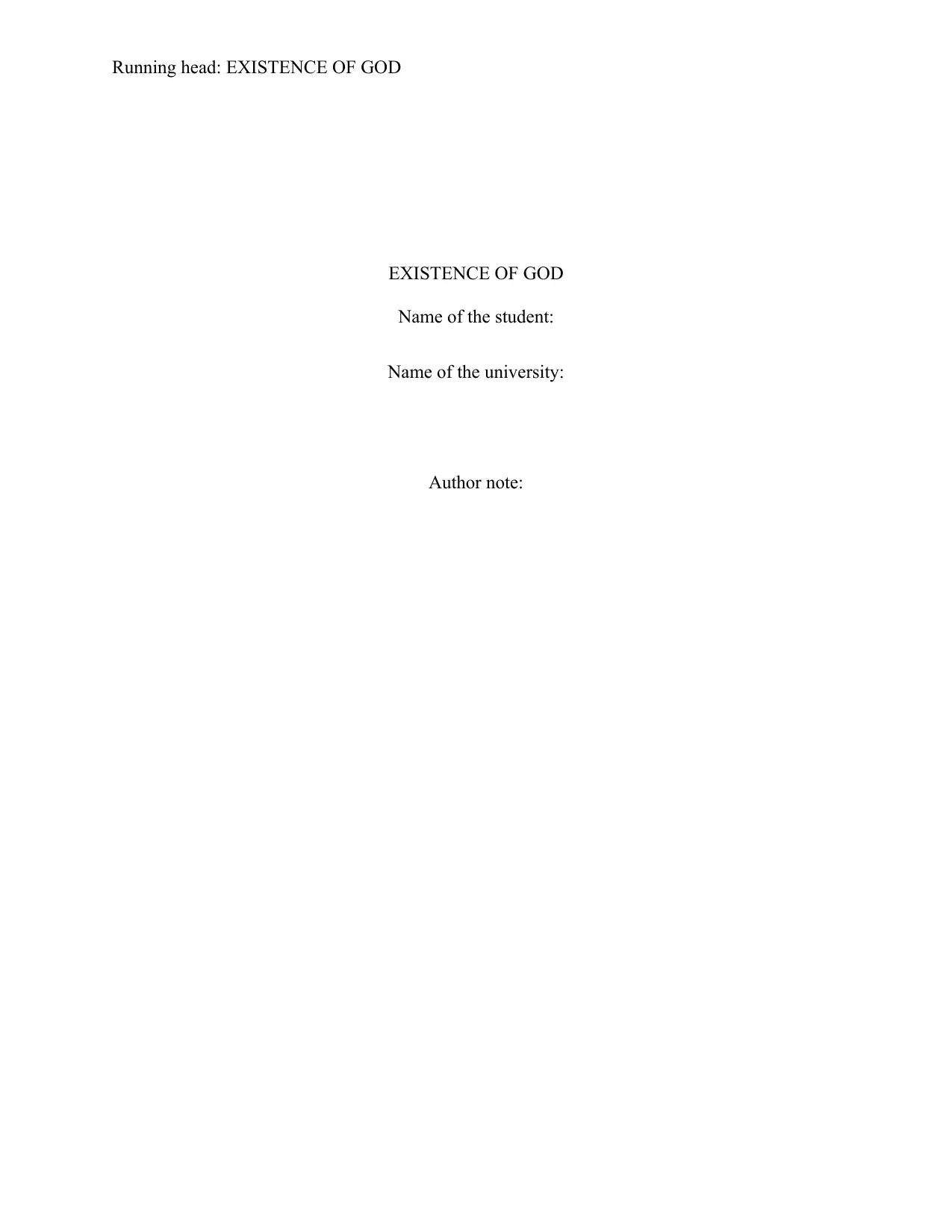
Running head: EXISTENCE OF GOD
EXISTENCE OF GOD
Name of the student:
Name of the university:
Author note:
EXISTENCE OF GOD
Name of the student:
Name of the university:
Author note:
Paraphrase This Document
Need a fresh take? Get an instant paraphrase of this document with our AI Paraphraser
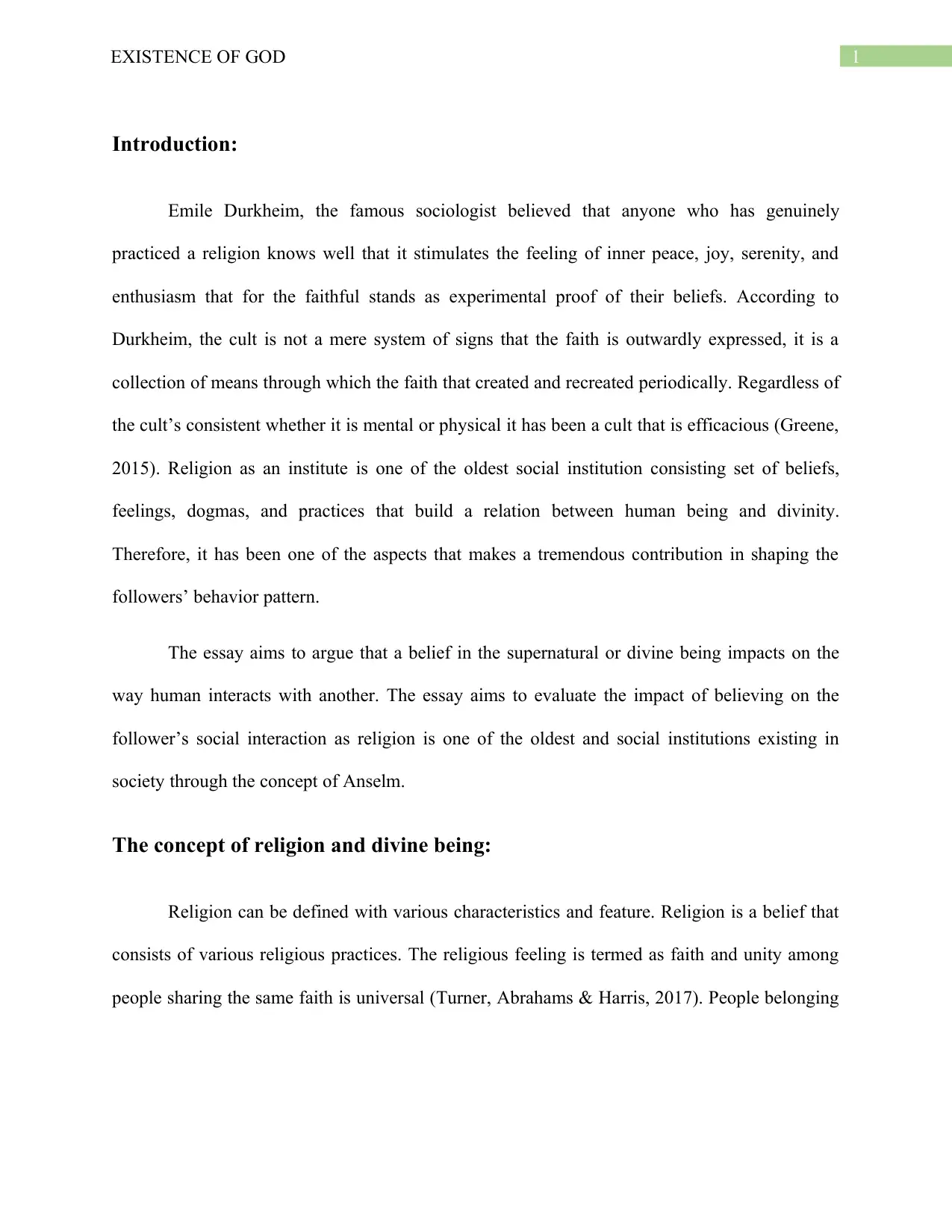
1EXISTENCE OF GOD
Introduction:
Emile Durkheim, the famous sociologist believed that anyone who has genuinely
practiced a religion knows well that it stimulates the feeling of inner peace, joy, serenity, and
enthusiasm that for the faithful stands as experimental proof of their beliefs. According to
Durkheim, the cult is not a mere system of signs that the faith is outwardly expressed, it is a
collection of means through which the faith that created and recreated periodically. Regardless of
the cult’s consistent whether it is mental or physical it has been a cult that is efficacious (Greene,
2015). Religion as an institute is one of the oldest social institution consisting set of beliefs,
feelings, dogmas, and practices that build a relation between human being and divinity.
Therefore, it has been one of the aspects that makes a tremendous contribution in shaping the
followers’ behavior pattern.
The essay aims to argue that a belief in the supernatural or divine being impacts on the
way human interacts with another. The essay aims to evaluate the impact of believing on the
follower’s social interaction as religion is one of the oldest and social institutions existing in
society through the concept of Anselm.
The concept of religion and divine being:
Religion can be defined with various characteristics and feature. Religion is a belief that
consists of various religious practices. The religious feeling is termed as faith and unity among
people sharing the same faith is universal (Turner, Abrahams & Harris, 2017). People belonging
Introduction:
Emile Durkheim, the famous sociologist believed that anyone who has genuinely
practiced a religion knows well that it stimulates the feeling of inner peace, joy, serenity, and
enthusiasm that for the faithful stands as experimental proof of their beliefs. According to
Durkheim, the cult is not a mere system of signs that the faith is outwardly expressed, it is a
collection of means through which the faith that created and recreated periodically. Regardless of
the cult’s consistent whether it is mental or physical it has been a cult that is efficacious (Greene,
2015). Religion as an institute is one of the oldest social institution consisting set of beliefs,
feelings, dogmas, and practices that build a relation between human being and divinity.
Therefore, it has been one of the aspects that makes a tremendous contribution in shaping the
followers’ behavior pattern.
The essay aims to argue that a belief in the supernatural or divine being impacts on the
way human interacts with another. The essay aims to evaluate the impact of believing on the
follower’s social interaction as religion is one of the oldest and social institutions existing in
society through the concept of Anselm.
The concept of religion and divine being:
Religion can be defined with various characteristics and feature. Religion is a belief that
consists of various religious practices. The religious feeling is termed as faith and unity among
people sharing the same faith is universal (Turner, Abrahams & Harris, 2017). People belonging
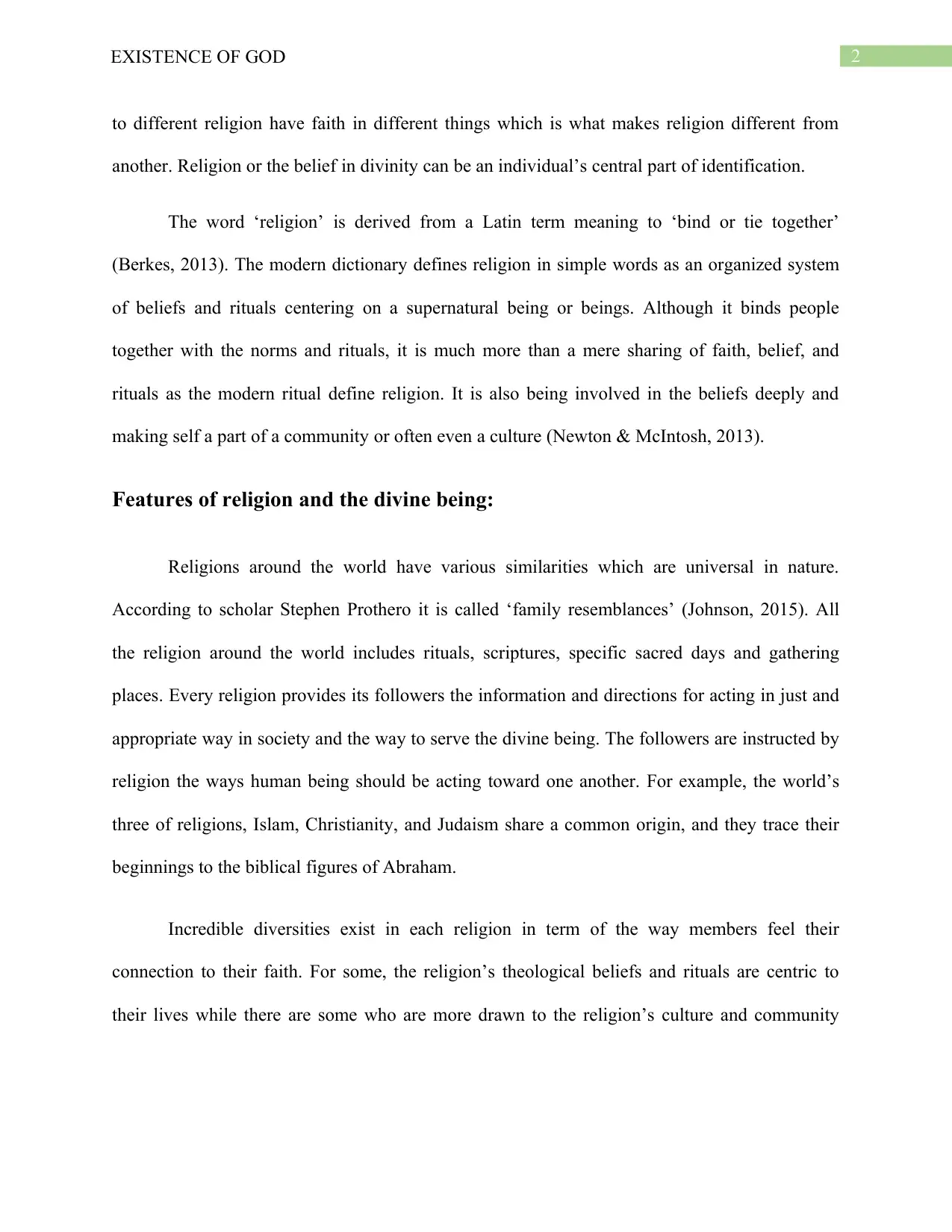
2EXISTENCE OF GOD
to different religion have faith in different things which is what makes religion different from
another. Religion or the belief in divinity can be an individual’s central part of identification.
The word ‘religion’ is derived from a Latin term meaning to ‘bind or tie together’
(Berkes, 2013). The modern dictionary defines religion in simple words as an organized system
of beliefs and rituals centering on a supernatural being or beings. Although it binds people
together with the norms and rituals, it is much more than a mere sharing of faith, belief, and
rituals as the modern ritual define religion. It is also being involved in the beliefs deeply and
making self a part of a community or often even a culture (Newton & McIntosh, 2013).
Features of religion and the divine being:
Religions around the world have various similarities which are universal in nature.
According to scholar Stephen Prothero it is called ‘family resemblances’ (Johnson, 2015). All
the religion around the world includes rituals, scriptures, specific sacred days and gathering
places. Every religion provides its followers the information and directions for acting in just and
appropriate way in society and the way to serve the divine being. The followers are instructed by
religion the ways human being should be acting toward one another. For example, the world’s
three of religions, Islam, Christianity, and Judaism share a common origin, and they trace their
beginnings to the biblical figures of Abraham.
Incredible diversities exist in each religion in term of the way members feel their
connection to their faith. For some, the religion’s theological beliefs and rituals are centric to
their lives while there are some who are more drawn to the religion’s culture and community
to different religion have faith in different things which is what makes religion different from
another. Religion or the belief in divinity can be an individual’s central part of identification.
The word ‘religion’ is derived from a Latin term meaning to ‘bind or tie together’
(Berkes, 2013). The modern dictionary defines religion in simple words as an organized system
of beliefs and rituals centering on a supernatural being or beings. Although it binds people
together with the norms and rituals, it is much more than a mere sharing of faith, belief, and
rituals as the modern ritual define religion. It is also being involved in the beliefs deeply and
making self a part of a community or often even a culture (Newton & McIntosh, 2013).
Features of religion and the divine being:
Religions around the world have various similarities which are universal in nature.
According to scholar Stephen Prothero it is called ‘family resemblances’ (Johnson, 2015). All
the religion around the world includes rituals, scriptures, specific sacred days and gathering
places. Every religion provides its followers the information and directions for acting in just and
appropriate way in society and the way to serve the divine being. The followers are instructed by
religion the ways human being should be acting toward one another. For example, the world’s
three of religions, Islam, Christianity, and Judaism share a common origin, and they trace their
beginnings to the biblical figures of Abraham.
Incredible diversities exist in each religion in term of the way members feel their
connection to their faith. For some, the religion’s theological beliefs and rituals are centric to
their lives while there are some who are more drawn to the religion’s culture and community
⊘ This is a preview!⊘
Do you want full access?
Subscribe today to unlock all pages.

Trusted by 1+ million students worldwide
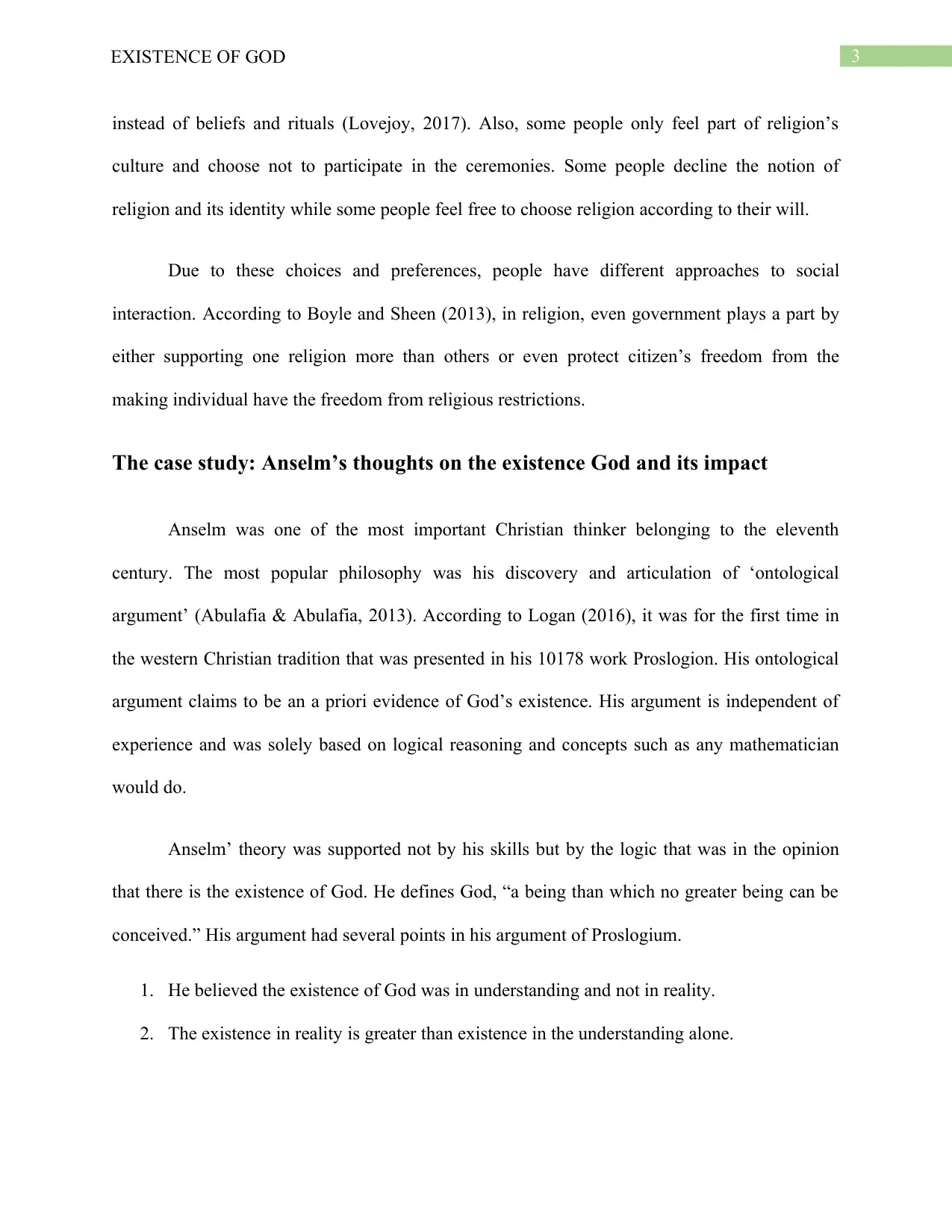
3EXISTENCE OF GOD
instead of beliefs and rituals (Lovejoy, 2017). Also, some people only feel part of religion’s
culture and choose not to participate in the ceremonies. Some people decline the notion of
religion and its identity while some people feel free to choose religion according to their will.
Due to these choices and preferences, people have different approaches to social
interaction. According to Boyle and Sheen (2013), in religion, even government plays a part by
either supporting one religion more than others or even protect citizen’s freedom from the
making individual have the freedom from religious restrictions.
The case study: Anselm’s thoughts on the existence God and its impact
Anselm was one of the most important Christian thinker belonging to the eleventh
century. The most popular philosophy was his discovery and articulation of ‘ontological
argument’ (Abulafia & Abulafia, 2013). According to Logan (2016), it was for the first time in
the western Christian tradition that was presented in his 10178 work Proslogion. His ontological
argument claims to be an a priori evidence of God’s existence. His argument is independent of
experience and was solely based on logical reasoning and concepts such as any mathematician
would do.
Anselm’ theory was supported not by his skills but by the logic that was in the opinion
that there is the existence of God. He defines God, “a being than which no greater being can be
conceived.” His argument had several points in his argument of Proslogium.
1. He believed the existence of God was in understanding and not in reality.
2. The existence in reality is greater than existence in the understanding alone.
instead of beliefs and rituals (Lovejoy, 2017). Also, some people only feel part of religion’s
culture and choose not to participate in the ceremonies. Some people decline the notion of
religion and its identity while some people feel free to choose religion according to their will.
Due to these choices and preferences, people have different approaches to social
interaction. According to Boyle and Sheen (2013), in religion, even government plays a part by
either supporting one religion more than others or even protect citizen’s freedom from the
making individual have the freedom from religious restrictions.
The case study: Anselm’s thoughts on the existence God and its impact
Anselm was one of the most important Christian thinker belonging to the eleventh
century. The most popular philosophy was his discovery and articulation of ‘ontological
argument’ (Abulafia & Abulafia, 2013). According to Logan (2016), it was for the first time in
the western Christian tradition that was presented in his 10178 work Proslogion. His ontological
argument claims to be an a priori evidence of God’s existence. His argument is independent of
experience and was solely based on logical reasoning and concepts such as any mathematician
would do.
Anselm’ theory was supported not by his skills but by the logic that was in the opinion
that there is the existence of God. He defines God, “a being than which no greater being can be
conceived.” His argument had several points in his argument of Proslogium.
1. He believed the existence of God was in understanding and not in reality.
2. The existence in reality is greater than existence in the understanding alone.
Paraphrase This Document
Need a fresh take? Get an instant paraphrase of this document with our AI Paraphraser
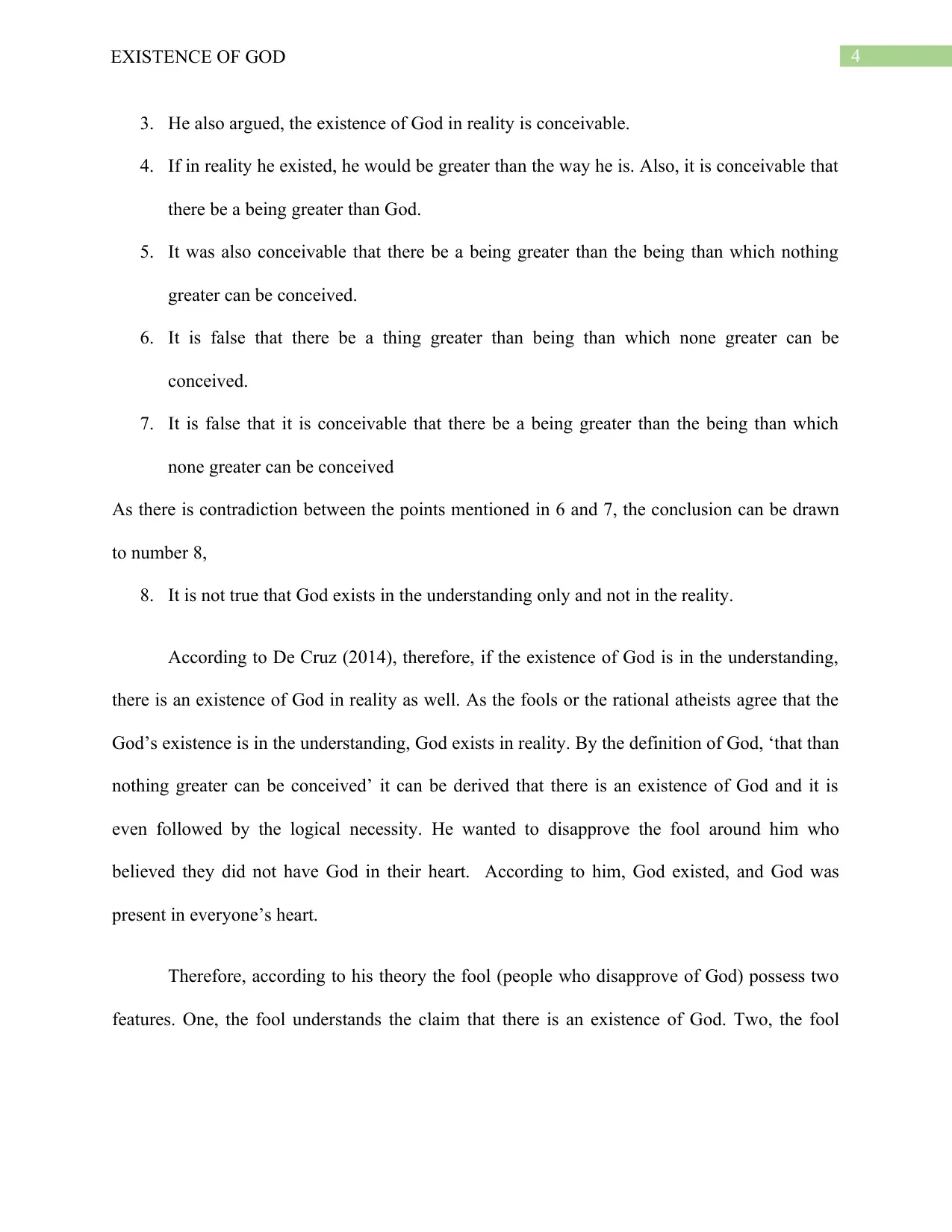
4EXISTENCE OF GOD
3. He also argued, the existence of God in reality is conceivable.
4. If in reality he existed, he would be greater than the way he is. Also, it is conceivable that
there be a being greater than God.
5. It was also conceivable that there be a being greater than the being than which nothing
greater can be conceived.
6. It is false that there be a thing greater than being than which none greater can be
conceived.
7. It is false that it is conceivable that there be a being greater than the being than which
none greater can be conceived
As there is contradiction between the points mentioned in 6 and 7, the conclusion can be drawn
to number 8,
8. It is not true that God exists in the understanding only and not in the reality.
According to De Cruz (2014), therefore, if the existence of God is in the understanding,
there is an existence of God in reality as well. As the fools or the rational atheists agree that the
God’s existence is in the understanding, God exists in reality. By the definition of God, ‘that than
nothing greater can be conceived’ it can be derived that there is an existence of God and it is
even followed by the logical necessity. He wanted to disapprove the fool around him who
believed they did not have God in their heart. According to him, God existed, and God was
present in everyone’s heart.
Therefore, according to his theory the fool (people who disapprove of God) possess two
features. One, the fool understands the claim that there is an existence of God. Two, the fool
3. He also argued, the existence of God in reality is conceivable.
4. If in reality he existed, he would be greater than the way he is. Also, it is conceivable that
there be a being greater than God.
5. It was also conceivable that there be a being greater than the being than which nothing
greater can be conceived.
6. It is false that there be a thing greater than being than which none greater can be
conceived.
7. It is false that it is conceivable that there be a being greater than the being than which
none greater can be conceived
As there is contradiction between the points mentioned in 6 and 7, the conclusion can be drawn
to number 8,
8. It is not true that God exists in the understanding only and not in the reality.
According to De Cruz (2014), therefore, if the existence of God is in the understanding,
there is an existence of God in reality as well. As the fools or the rational atheists agree that the
God’s existence is in the understanding, God exists in reality. By the definition of God, ‘that than
nothing greater can be conceived’ it can be derived that there is an existence of God and it is
even followed by the logical necessity. He wanted to disapprove the fool around him who
believed they did not have God in their heart. According to him, God existed, and God was
present in everyone’s heart.
Therefore, according to his theory the fool (people who disapprove of God) possess two
features. One, the fool understands the claim that there is an existence of God. Two, the fool
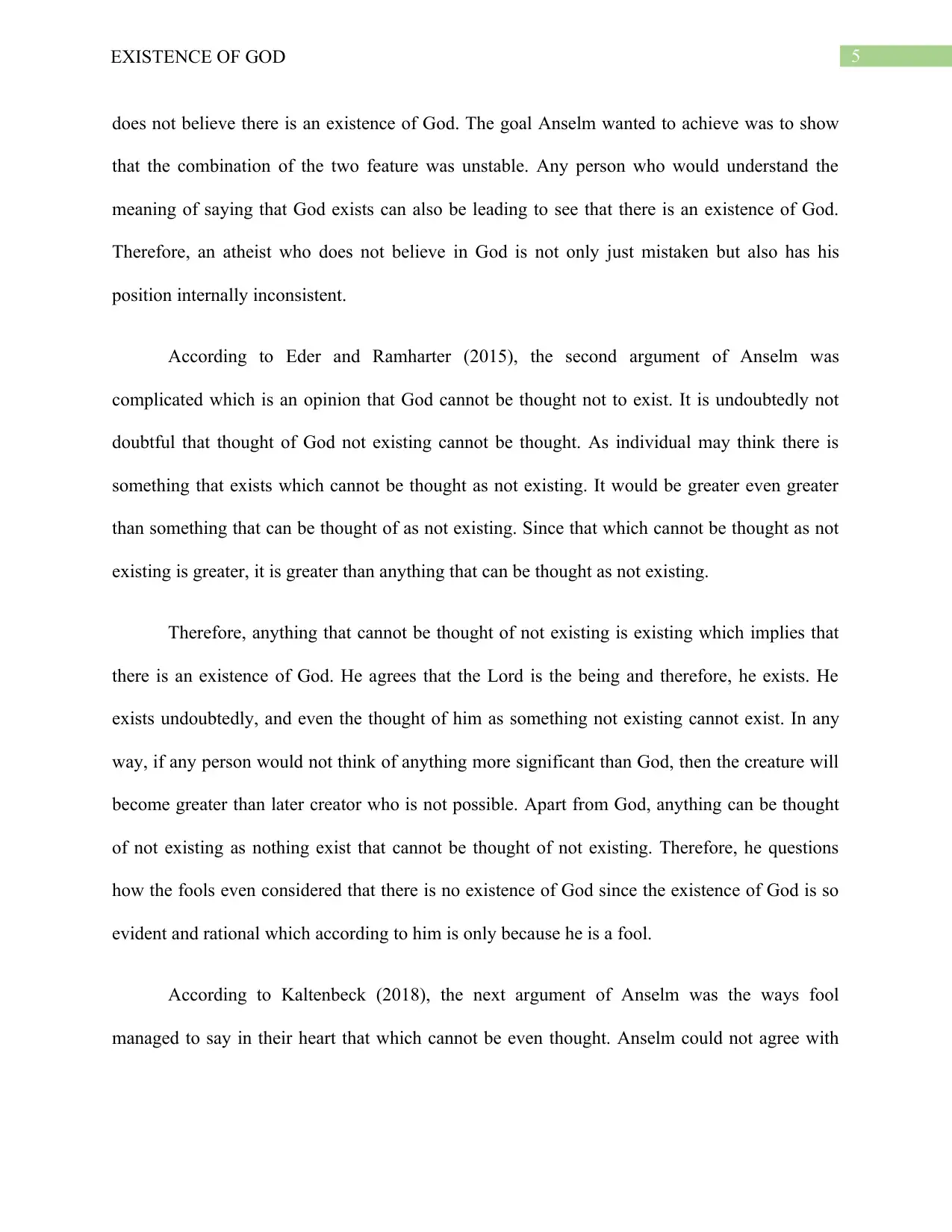
5EXISTENCE OF GOD
does not believe there is an existence of God. The goal Anselm wanted to achieve was to show
that the combination of the two feature was unstable. Any person who would understand the
meaning of saying that God exists can also be leading to see that there is an existence of God.
Therefore, an atheist who does not believe in God is not only just mistaken but also has his
position internally inconsistent.
According to Eder and Ramharter (2015), the second argument of Anselm was
complicated which is an opinion that God cannot be thought not to exist. It is undoubtedly not
doubtful that thought of God not existing cannot be thought. As individual may think there is
something that exists which cannot be thought as not existing. It would be greater even greater
than something that can be thought of as not existing. Since that which cannot be thought as not
existing is greater, it is greater than anything that can be thought as not existing.
Therefore, anything that cannot be thought of not existing is existing which implies that
there is an existence of God. He agrees that the Lord is the being and therefore, he exists. He
exists undoubtedly, and even the thought of him as something not existing cannot exist. In any
way, if any person would not think of anything more significant than God, then the creature will
become greater than later creator who is not possible. Apart from God, anything can be thought
of not existing as nothing exist that cannot be thought of not existing. Therefore, he questions
how the fools even considered that there is no existence of God since the existence of God is so
evident and rational which according to him is only because he is a fool.
According to Kaltenbeck (2018), the next argument of Anselm was the ways fool
managed to say in their heart that which cannot be even thought. Anselm could not agree with
does not believe there is an existence of God. The goal Anselm wanted to achieve was to show
that the combination of the two feature was unstable. Any person who would understand the
meaning of saying that God exists can also be leading to see that there is an existence of God.
Therefore, an atheist who does not believe in God is not only just mistaken but also has his
position internally inconsistent.
According to Eder and Ramharter (2015), the second argument of Anselm was
complicated which is an opinion that God cannot be thought not to exist. It is undoubtedly not
doubtful that thought of God not existing cannot be thought. As individual may think there is
something that exists which cannot be thought as not existing. It would be greater even greater
than something that can be thought of as not existing. Since that which cannot be thought as not
existing is greater, it is greater than anything that can be thought as not existing.
Therefore, anything that cannot be thought of not existing is existing which implies that
there is an existence of God. He agrees that the Lord is the being and therefore, he exists. He
exists undoubtedly, and even the thought of him as something not existing cannot exist. In any
way, if any person would not think of anything more significant than God, then the creature will
become greater than later creator who is not possible. Apart from God, anything can be thought
of not existing as nothing exist that cannot be thought of not existing. Therefore, he questions
how the fools even considered that there is no existence of God since the existence of God is so
evident and rational which according to him is only because he is a fool.
According to Kaltenbeck (2018), the next argument of Anselm was the ways fool
managed to say in their heart that which cannot be even thought. Anselm could not agree with
⊘ This is a preview!⊘
Do you want full access?
Subscribe today to unlock all pages.

Trusted by 1+ million students worldwide
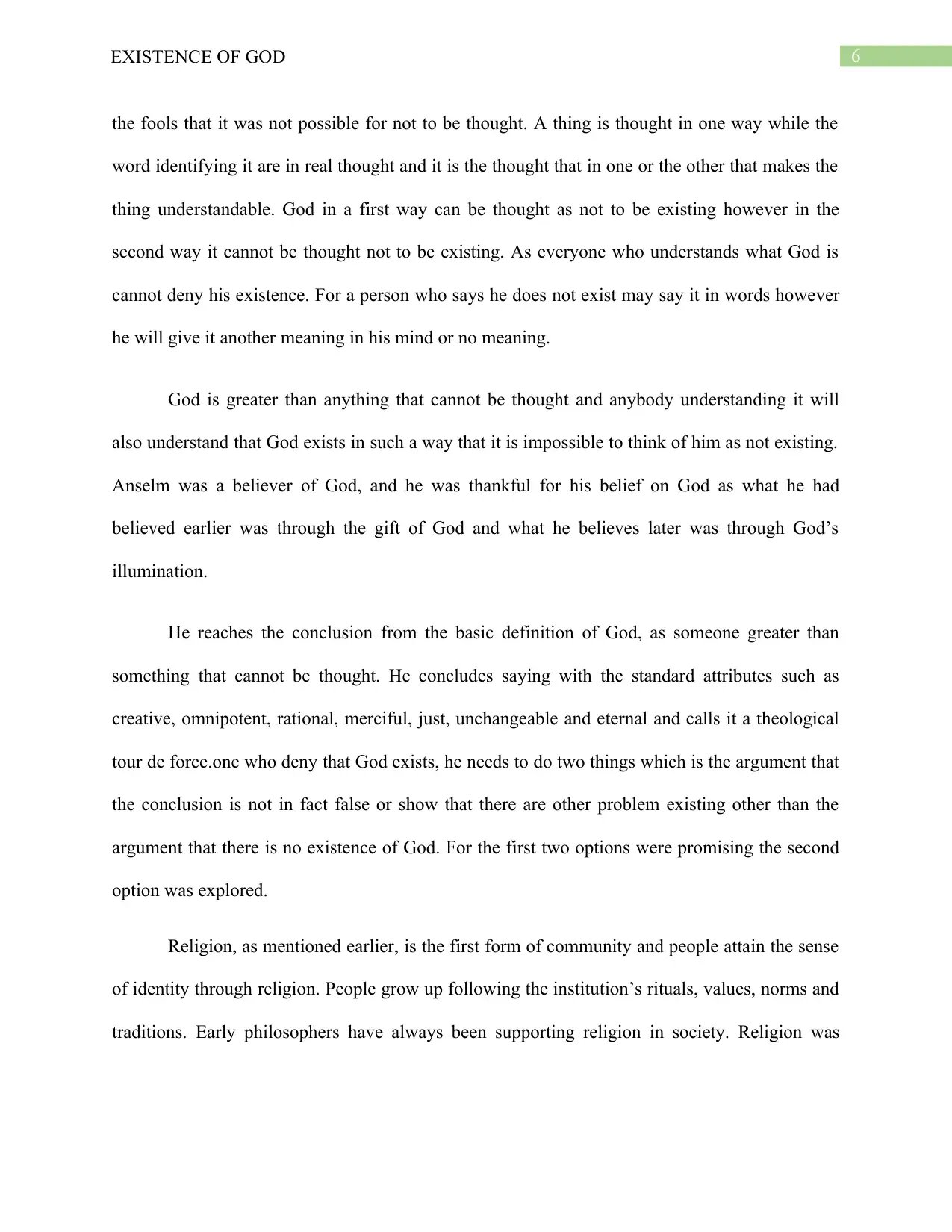
6EXISTENCE OF GOD
the fools that it was not possible for not to be thought. A thing is thought in one way while the
word identifying it are in real thought and it is the thought that in one or the other that makes the
thing understandable. God in a first way can be thought as not to be existing however in the
second way it cannot be thought not to be existing. As everyone who understands what God is
cannot deny his existence. For a person who says he does not exist may say it in words however
he will give it another meaning in his mind or no meaning.
God is greater than anything that cannot be thought and anybody understanding it will
also understand that God exists in such a way that it is impossible to think of him as not existing.
Anselm was a believer of God, and he was thankful for his belief on God as what he had
believed earlier was through the gift of God and what he believes later was through God’s
illumination.
He reaches the conclusion from the basic definition of God, as someone greater than
something that cannot be thought. He concludes saying with the standard attributes such as
creative, omnipotent, rational, merciful, just, unchangeable and eternal and calls it a theological
tour de force.one who deny that God exists, he needs to do two things which is the argument that
the conclusion is not in fact false or show that there are other problem existing other than the
argument that there is no existence of God. For the first two options were promising the second
option was explored.
Religion, as mentioned earlier, is the first form of community and people attain the sense
of identity through religion. People grow up following the institution’s rituals, values, norms and
traditions. Early philosophers have always been supporting religion in society. Religion was
the fools that it was not possible for not to be thought. A thing is thought in one way while the
word identifying it are in real thought and it is the thought that in one or the other that makes the
thing understandable. God in a first way can be thought as not to be existing however in the
second way it cannot be thought not to be existing. As everyone who understands what God is
cannot deny his existence. For a person who says he does not exist may say it in words however
he will give it another meaning in his mind or no meaning.
God is greater than anything that cannot be thought and anybody understanding it will
also understand that God exists in such a way that it is impossible to think of him as not existing.
Anselm was a believer of God, and he was thankful for his belief on God as what he had
believed earlier was through the gift of God and what he believes later was through God’s
illumination.
He reaches the conclusion from the basic definition of God, as someone greater than
something that cannot be thought. He concludes saying with the standard attributes such as
creative, omnipotent, rational, merciful, just, unchangeable and eternal and calls it a theological
tour de force.one who deny that God exists, he needs to do two things which is the argument that
the conclusion is not in fact false or show that there are other problem existing other than the
argument that there is no existence of God. For the first two options were promising the second
option was explored.
Religion, as mentioned earlier, is the first form of community and people attain the sense
of identity through religion. People grow up following the institution’s rituals, values, norms and
traditions. Early philosophers have always been supporting religion in society. Religion was
Paraphrase This Document
Need a fresh take? Get an instant paraphrase of this document with our AI Paraphraser
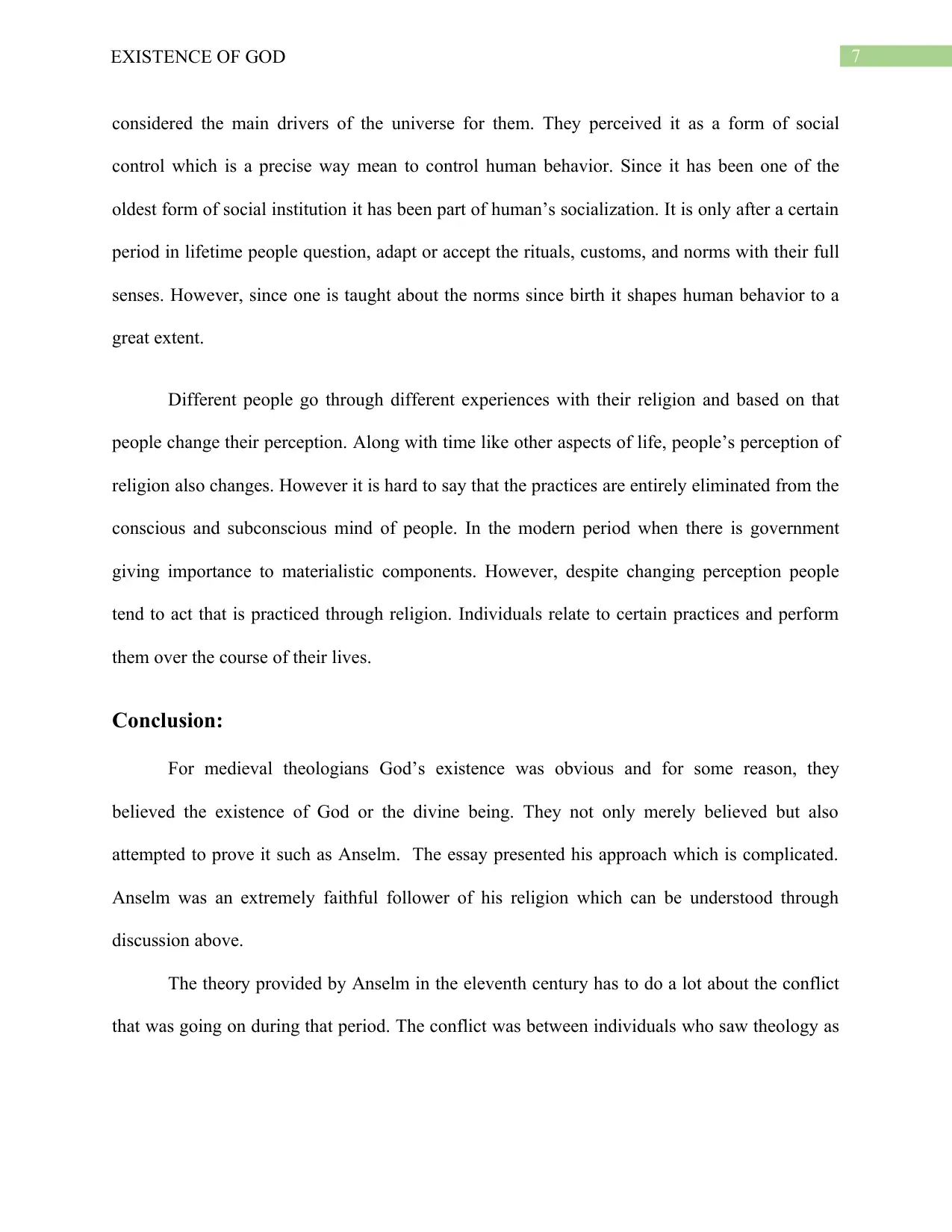
7EXISTENCE OF GOD
considered the main drivers of the universe for them. They perceived it as a form of social
control which is a precise way mean to control human behavior. Since it has been one of the
oldest form of social institution it has been part of human’s socialization. It is only after a certain
period in lifetime people question, adapt or accept the rituals, customs, and norms with their full
senses. However, since one is taught about the norms since birth it shapes human behavior to a
great extent.
Different people go through different experiences with their religion and based on that
people change their perception. Along with time like other aspects of life, people’s perception of
religion also changes. However it is hard to say that the practices are entirely eliminated from the
conscious and subconscious mind of people. In the modern period when there is government
giving importance to materialistic components. However, despite changing perception people
tend to act that is practiced through religion. Individuals relate to certain practices and perform
them over the course of their lives.
Conclusion:
For medieval theologians God’s existence was obvious and for some reason, they
believed the existence of God or the divine being. They not only merely believed but also
attempted to prove it such as Anselm. The essay presented his approach which is complicated.
Anselm was an extremely faithful follower of his religion which can be understood through
discussion above.
The theory provided by Anselm in the eleventh century has to do a lot about the conflict
that was going on during that period. The conflict was between individuals who saw theology as
considered the main drivers of the universe for them. They perceived it as a form of social
control which is a precise way mean to control human behavior. Since it has been one of the
oldest form of social institution it has been part of human’s socialization. It is only after a certain
period in lifetime people question, adapt or accept the rituals, customs, and norms with their full
senses. However, since one is taught about the norms since birth it shapes human behavior to a
great extent.
Different people go through different experiences with their religion and based on that
people change their perception. Along with time like other aspects of life, people’s perception of
religion also changes. However it is hard to say that the practices are entirely eliminated from the
conscious and subconscious mind of people. In the modern period when there is government
giving importance to materialistic components. However, despite changing perception people
tend to act that is practiced through religion. Individuals relate to certain practices and perform
them over the course of their lives.
Conclusion:
For medieval theologians God’s existence was obvious and for some reason, they
believed the existence of God or the divine being. They not only merely believed but also
attempted to prove it such as Anselm. The essay presented his approach which is complicated.
Anselm was an extremely faithful follower of his religion which can be understood through
discussion above.
The theory provided by Anselm in the eleventh century has to do a lot about the conflict
that was going on during that period. The conflict was between individuals who saw theology as
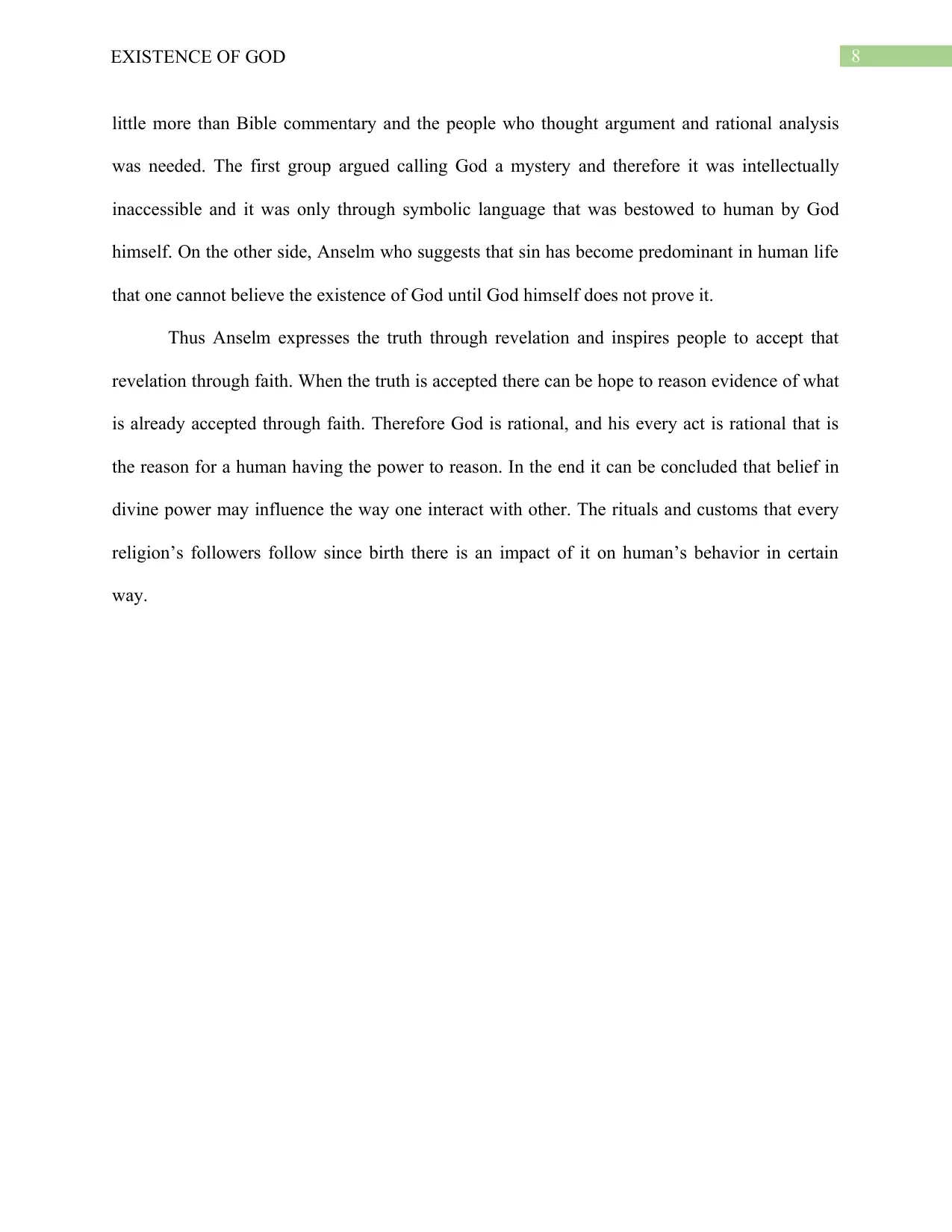
8EXISTENCE OF GOD
little more than Bible commentary and the people who thought argument and rational analysis
was needed. The first group argued calling God a mystery and therefore it was intellectually
inaccessible and it was only through symbolic language that was bestowed to human by God
himself. On the other side, Anselm who suggests that sin has become predominant in human life
that one cannot believe the existence of God until God himself does not prove it.
Thus Anselm expresses the truth through revelation and inspires people to accept that
revelation through faith. When the truth is accepted there can be hope to reason evidence of what
is already accepted through faith. Therefore God is rational, and his every act is rational that is
the reason for a human having the power to reason. In the end it can be concluded that belief in
divine power may influence the way one interact with other. The rituals and customs that every
religion’s followers follow since birth there is an impact of it on human’s behavior in certain
way.
little more than Bible commentary and the people who thought argument and rational analysis
was needed. The first group argued calling God a mystery and therefore it was intellectually
inaccessible and it was only through symbolic language that was bestowed to human by God
himself. On the other side, Anselm who suggests that sin has become predominant in human life
that one cannot believe the existence of God until God himself does not prove it.
Thus Anselm expresses the truth through revelation and inspires people to accept that
revelation through faith. When the truth is accepted there can be hope to reason evidence of what
is already accepted through faith. Therefore God is rational, and his every act is rational that is
the reason for a human having the power to reason. In the end it can be concluded that belief in
divine power may influence the way one interact with other. The rituals and customs that every
religion’s followers follow since birth there is an impact of it on human’s behavior in certain
way.
⊘ This is a preview!⊘
Do you want full access?
Subscribe today to unlock all pages.

Trusted by 1+ million students worldwide
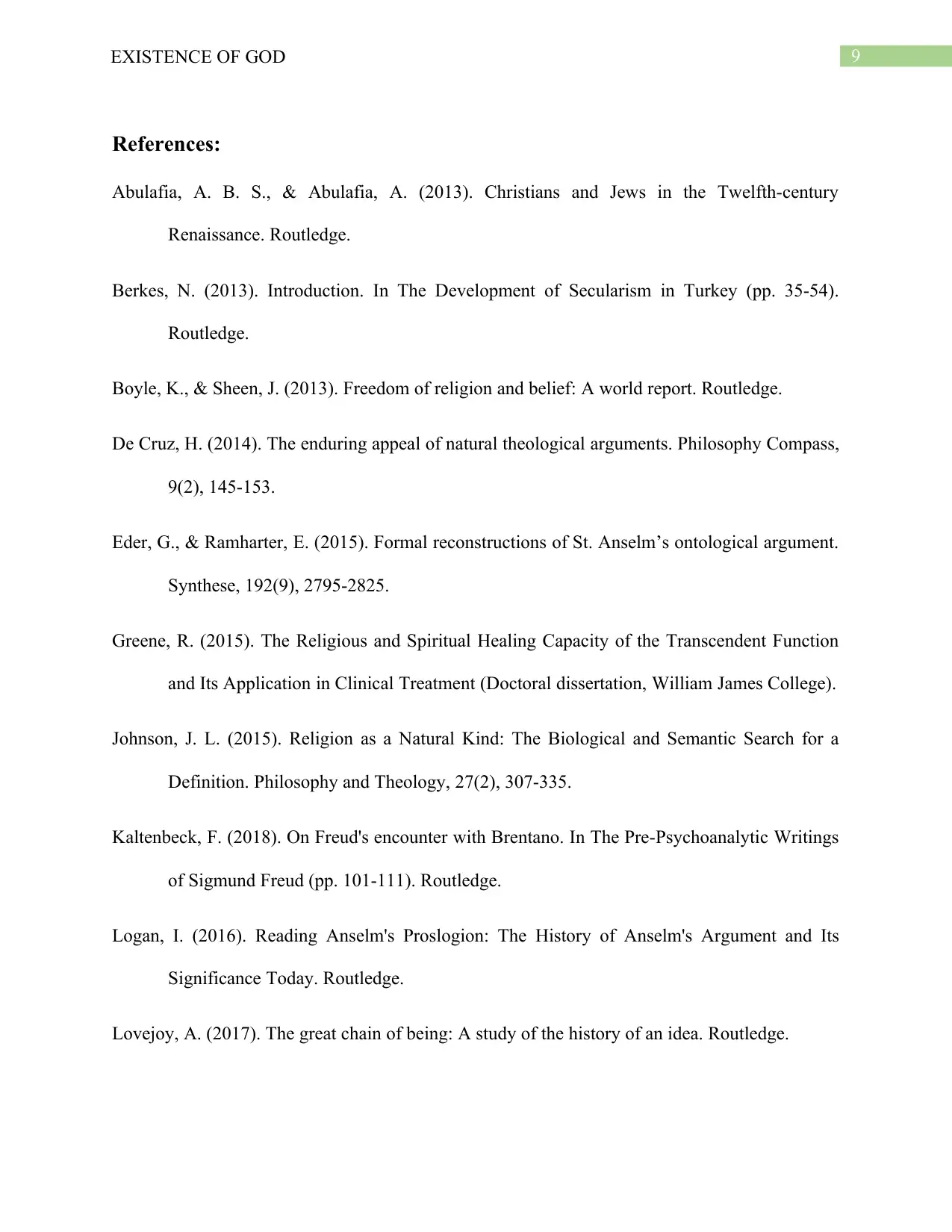
9EXISTENCE OF GOD
References:
Abulafia, A. B. S., & Abulafia, A. (2013). Christians and Jews in the Twelfth-century
Renaissance. Routledge.
Berkes, N. (2013). Introduction. In The Development of Secularism in Turkey (pp. 35-54).
Routledge.
Boyle, K., & Sheen, J. (2013). Freedom of religion and belief: A world report. Routledge.
De Cruz, H. (2014). The enduring appeal of natural theological arguments. Philosophy Compass,
9(2), 145-153.
Eder, G., & Ramharter, E. (2015). Formal reconstructions of St. Anselm’s ontological argument.
Synthese, 192(9), 2795-2825.
Greene, R. (2015). The Religious and Spiritual Healing Capacity of the Transcendent Function
and Its Application in Clinical Treatment (Doctoral dissertation, William James College).
Johnson, J. L. (2015). Religion as a Natural Kind: The Biological and Semantic Search for a
Definition. Philosophy and Theology, 27(2), 307-335.
Kaltenbeck, F. (2018). On Freud's encounter with Brentano. In The Pre-Psychoanalytic Writings
of Sigmund Freud (pp. 101-111). Routledge.
Logan, I. (2016). Reading Anselm's Proslogion: The History of Anselm's Argument and Its
Significance Today. Routledge.
Lovejoy, A. (2017). The great chain of being: A study of the history of an idea. Routledge.
References:
Abulafia, A. B. S., & Abulafia, A. (2013). Christians and Jews in the Twelfth-century
Renaissance. Routledge.
Berkes, N. (2013). Introduction. In The Development of Secularism in Turkey (pp. 35-54).
Routledge.
Boyle, K., & Sheen, J. (2013). Freedom of religion and belief: A world report. Routledge.
De Cruz, H. (2014). The enduring appeal of natural theological arguments. Philosophy Compass,
9(2), 145-153.
Eder, G., & Ramharter, E. (2015). Formal reconstructions of St. Anselm’s ontological argument.
Synthese, 192(9), 2795-2825.
Greene, R. (2015). The Religious and Spiritual Healing Capacity of the Transcendent Function
and Its Application in Clinical Treatment (Doctoral dissertation, William James College).
Johnson, J. L. (2015). Religion as a Natural Kind: The Biological and Semantic Search for a
Definition. Philosophy and Theology, 27(2), 307-335.
Kaltenbeck, F. (2018). On Freud's encounter with Brentano. In The Pre-Psychoanalytic Writings
of Sigmund Freud (pp. 101-111). Routledge.
Logan, I. (2016). Reading Anselm's Proslogion: The History of Anselm's Argument and Its
Significance Today. Routledge.
Lovejoy, A. (2017). The great chain of being: A study of the history of an idea. Routledge.
Paraphrase This Document
Need a fresh take? Get an instant paraphrase of this document with our AI Paraphraser
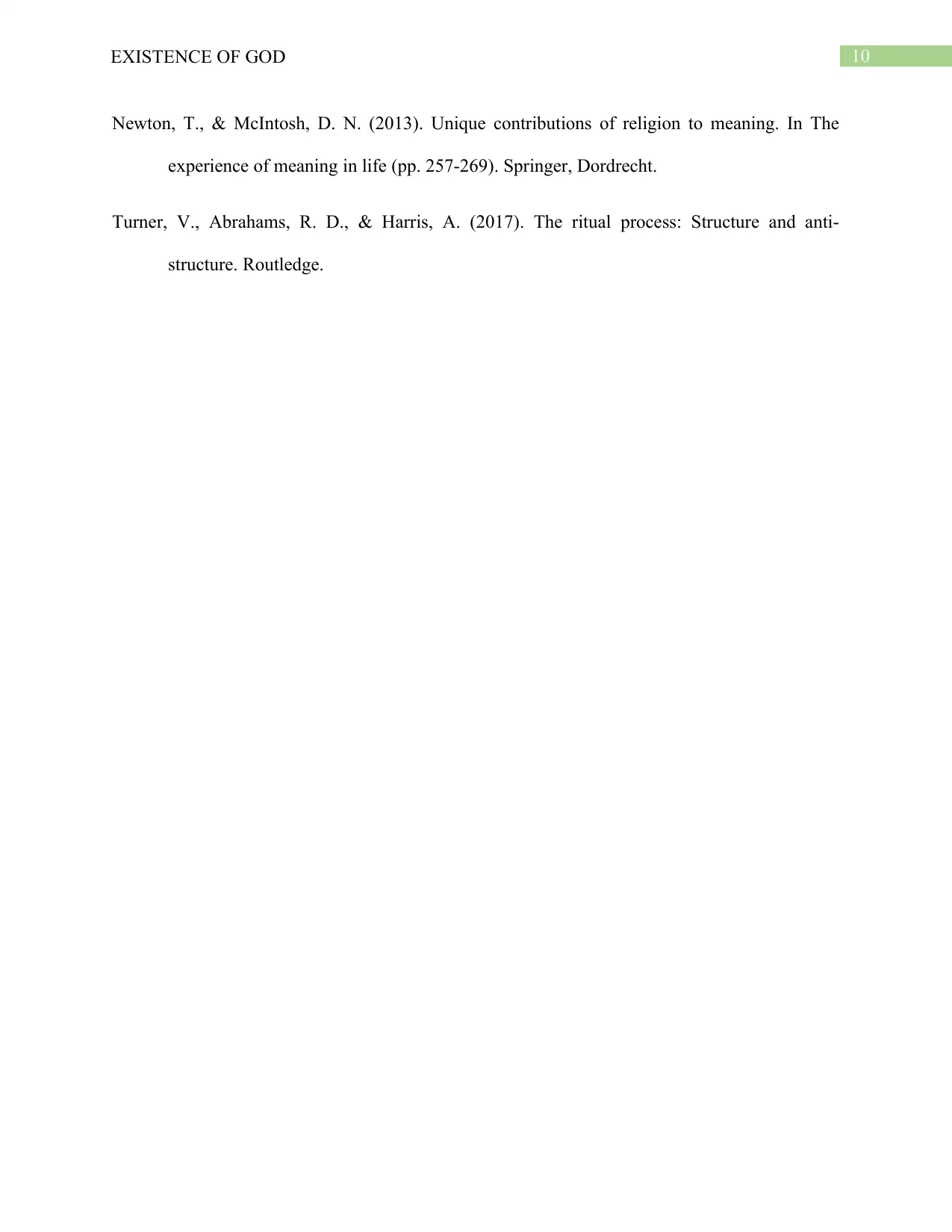
10EXISTENCE OF GOD
Newton, T., & McIntosh, D. N. (2013). Unique contributions of religion to meaning. In The
experience of meaning in life (pp. 257-269). Springer, Dordrecht.
Turner, V., Abrahams, R. D., & Harris, A. (2017). The ritual process: Structure and anti-
structure. Routledge.
Newton, T., & McIntosh, D. N. (2013). Unique contributions of religion to meaning. In The
experience of meaning in life (pp. 257-269). Springer, Dordrecht.
Turner, V., Abrahams, R. D., & Harris, A. (2017). The ritual process: Structure and anti-
structure. Routledge.
1 out of 11
Related Documents
Your All-in-One AI-Powered Toolkit for Academic Success.
+13062052269
info@desklib.com
Available 24*7 on WhatsApp / Email
![[object Object]](/_next/static/media/star-bottom.7253800d.svg)
Unlock your academic potential
Copyright © 2020–2025 A2Z Services. All Rights Reserved. Developed and managed by ZUCOL.





